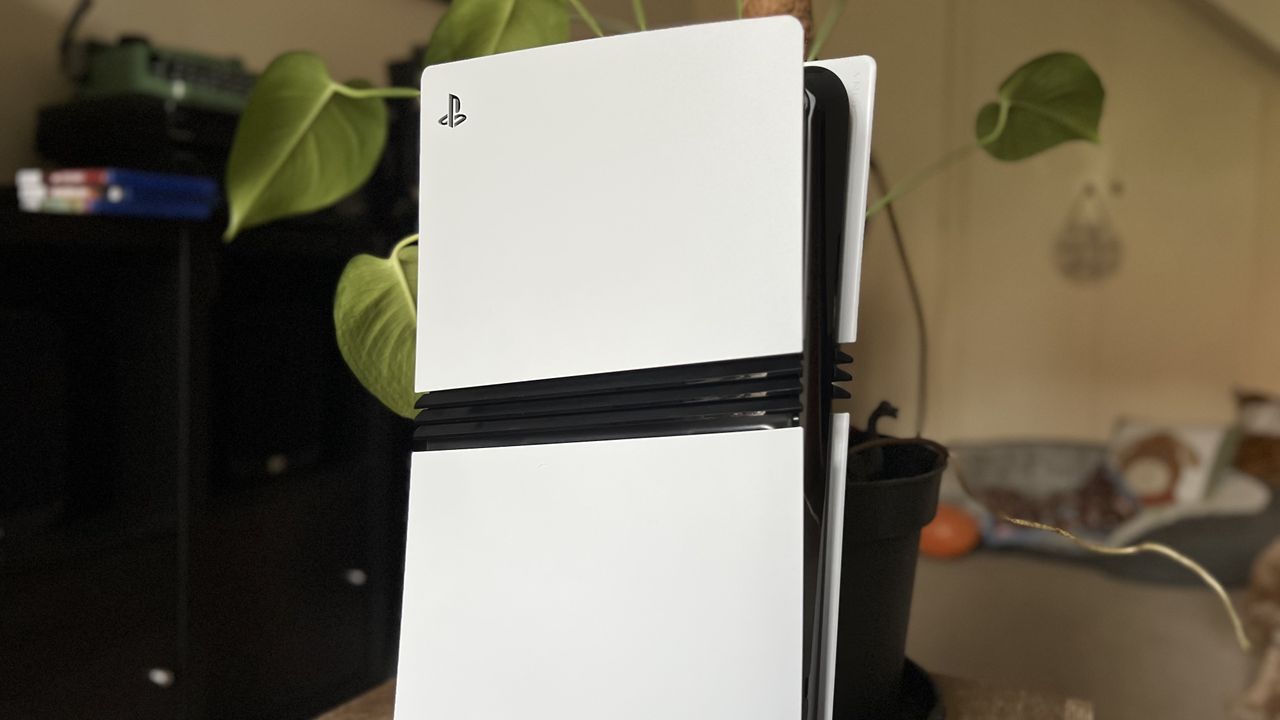
My mother would be shocked at my actions this weekend. I ripped a brand-new PS5 Pro from the box, hooked it up, and sat three inches away from the screen for about eight hours straight. This is Sony’s big mid-cycle refresh, promising 67% more compute cores, 28% faster RAM, and 45% faster rendering - a party line of percentages that have had PS5 owners’ eyebrows raised for weeks.
It has three goals; hit smooth 4K 60fps gameplay, improve ray tracing with more details, and upscale games for better clarity. If those goals align with your own, this is the only PlayStation on the market for you. If you don’t already know that they do, your money is better spent elsewhere.
Like many original 2020 owners, I’ve been waiting to see what a mid-cycle update can offer me. My console is still running just as well as it did on launch day, but the promise of more had my interest piqued in September. The PS5 Pro has sat in pride of place in my living room for a week now, and I’m not convinced I’ll be buying one when it inevitably gets taken off me.
Design
I felt a bit old when I opened the PS5 Pro’s box, a little like how my grandparents might have looked at the first mobile phones and recalled their own chunky landlines from back in the day. I knew the Slim made changes to the PS5’s overall design, but I wasn’t expecting to be so impressed with even the Pro’s slightly larger form factor. The device looks and feels like a true next-generation piece of tech, so much so that I felt nostalgic for a time when I thought the original console was futuristic. Compared to the slick lines, svelte middle, and cropped plates, my original might as well be in a museum.
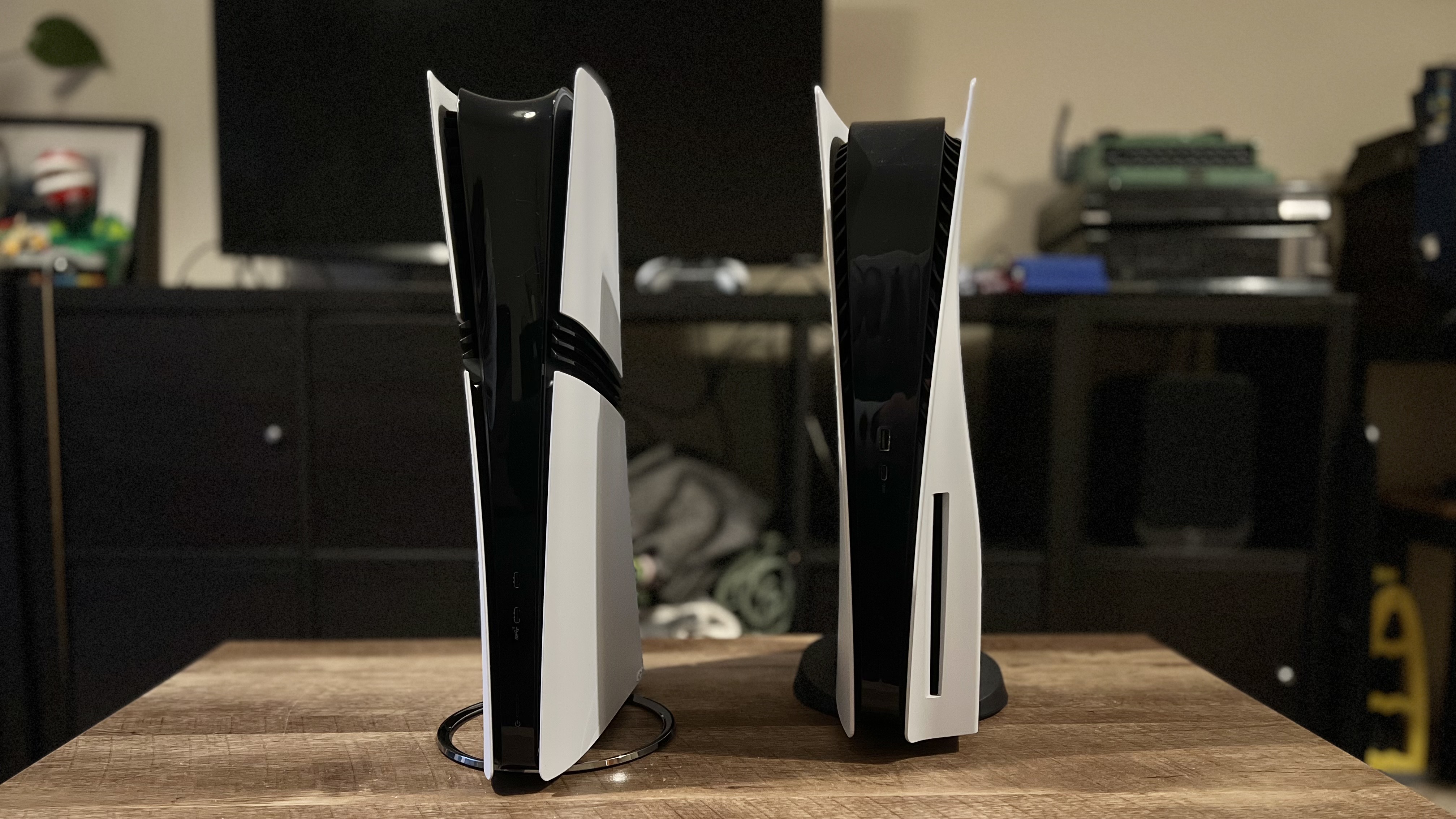
Sony has managed to squeeze its internal improvements into a chassis that also reduces size. That’s no mean feat, and while we’re technically two generations of the PS5 ahead, with the Slim coming in shorter than the Pro, it’s still amazing to see all this tech stuffed into such a small form factor.
It’s also a much cleaner design overall. Where the original PS5’s curves give it an indistinct shape, the Pro’s cinched silhouette keeps everything tightly angular. The fins, chunkier than the stripe on the PS5 Slim, break up the sides nicely to step away from the amorphous slopes of the previous console. That closer crop means everything feels a little more durable under-hand as well. The shorter panel lips don’t feel like they could snap off anymore, and the rear section doesn’t jut out nearly as far. Even the stand (sold separately, as are most of the PS5 Pro’s accessories) looks and feels more grown up and reliable.
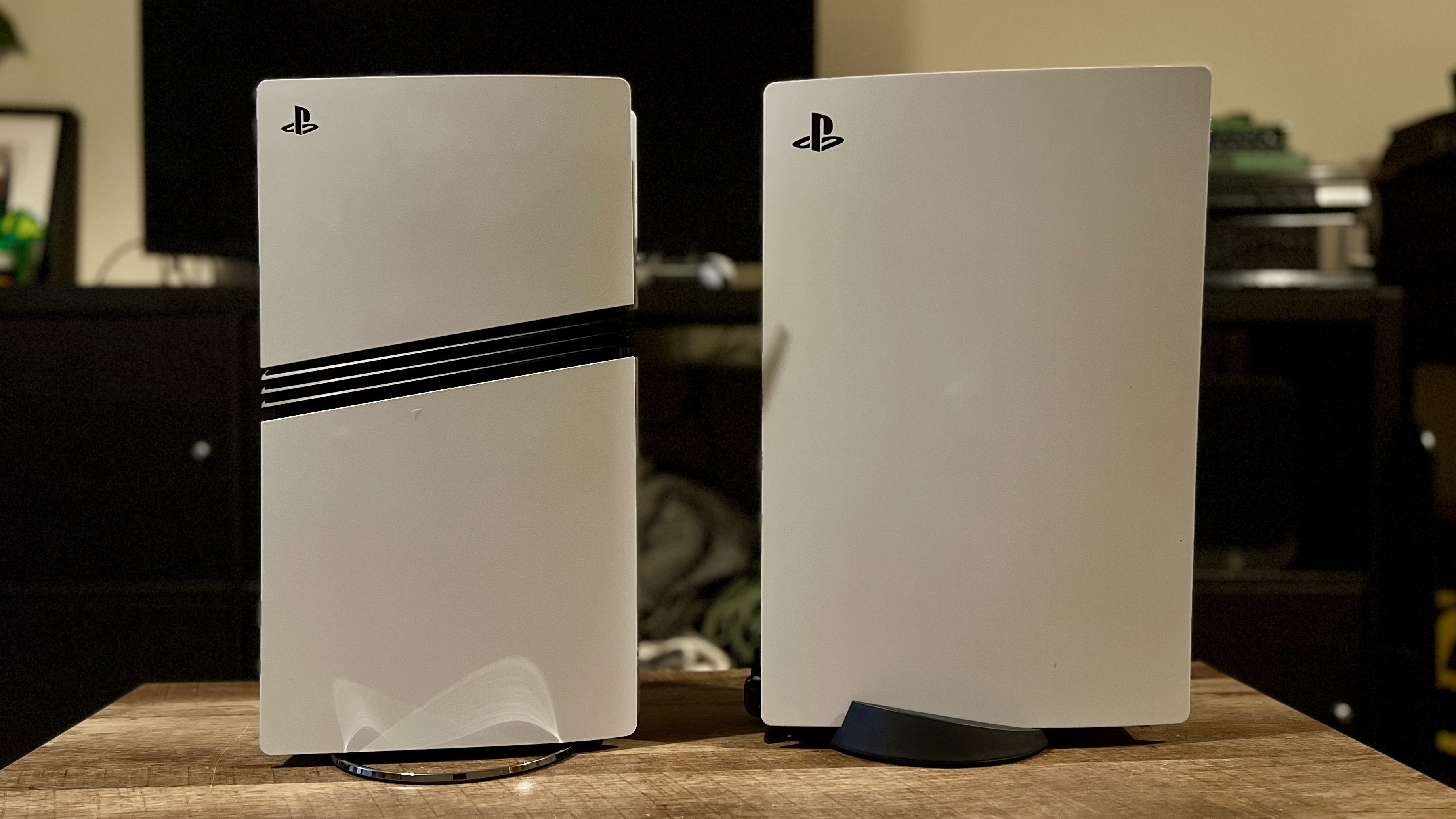
The original stand is essentially a chunk of plastic that seats the PS5 in the middle with no real support. The new metallic ring screws directly into the bottom of the console and stays put. I can’t tell you how many times I’ve knocked my original console and only realized it’s leaning at an angle after the fact, everything is far less precarious here.
Even the black curved middle has been improved in this design, with a slightly concave shape that catches light better and doesn’t appear as blocky as the original. It’s a smaller touch, but it makes the Pro look far more dynamic overall. There are now two USB-C ports embedded in this front panel, replacing a USB-A on the original console. Don’t worry if your accessories still run off the older format, though, the rear IO still features two USB-A options and an Ethernet port.

That classic PS5 lighting has changed from my day as well. The LEDs are now more focused towards the bottom of the console than the top, illuminating from the ground up with cleaner lines and less bleed overall. The original console has light bouncing around the larger side panels, but keeping everything focused towards the bottom means it’s more contained and the fade effect is emphasized even more.
Of course, Sony still has its own stamp on the console. As well as the logo imprinted on the side of the inside of the right plate and the PlayStation cut-out on the outside of the left, the Pro also features an embossed set of the brand’s icons on a lower flank.
Setup
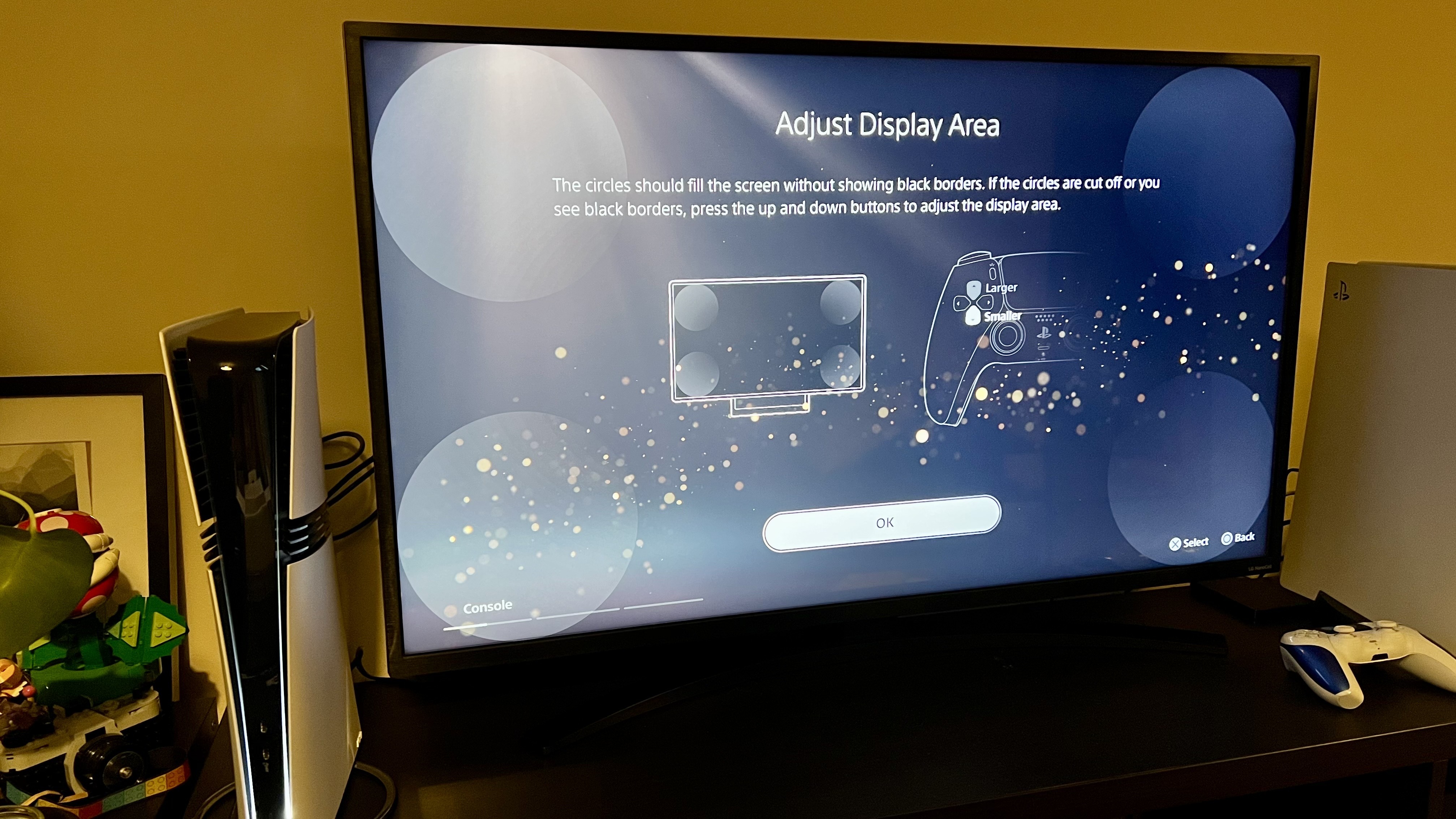
The setup process for the PS5 Pro appears identical to the original model - there’s not even a mention of your $200 investment on the welcome splash screen at the end. All in all the process takes around ten to fifteen minutes across both physical and software setup.
The PS5 Pro is ready to go straight out the box, with two transparent clips available for mounting the console on its side. The process of installing the vertical stand, if you picked it up separately, is pretty painless. Simply remove the plastic cap from the bottom of the console and screw in the base. Once you’ve plugged in the power cord and supplied HDMI 2.1 cable, you’re all good to go. From here, you’ll run through internet setup, display area and HDR settings, and rest mode preferences.
The system requires a few minutes to update itself before fully loading up, though this only took around four minutes for me, including three restarts and 30 seconds tacked onto the end for the DualSense update.
Performance
The PS5 Pro will live and die by its performance. This is a machine designed around a GPU boost, but rather than simply waving a higher resolution flag the Pro is specific in the improvements it makes to your games. Its basic function is to run your games at 4K, 60fps. The previous model can do either at once, but rarely both - enter new graphical modes, often labeled as Pro in the in-game menus. This is where that GPU boost is most noticeable - games genuinely do run smoother at full ray tracing 4K on the Pro than they do on the original PS5.
An existing PS5 owner will still feel great zipping through Manhattan on the original console, but a PS5 Pro owner will feel just that little bit better. Motion feels less jagged, the camera pans effortlessly through each frame, and action snaps crisply into place. I never had a problem with framerates on the original console - but sometimes you only notice a noise once it stops.
Marvel's Spider-Man 2 was the last game I tested on the PS5 Pro, but it’s also one of the more impressive implementations of Sony’s new tech. Smaller graphical improvements like enhanced background details and additional ray tracing effects shine through brightest when pitted against busy New York streets. Cerny’s inference that we’ll no longer need to choose between visual quality and frame speed is under a little scrutiny here, though. It’s true, the PS5 Pro does offer the same high-end visual quality as the PS5’s Fidelity mode while hitting 60fps in Performance Pro settings - but now there’s a new Fidelity Pro mode to move the goalposts as well. This mode brings in newer ray tracing (boosting lighting information, motion handling, and key light shadows) across reflections and details while capping framerates at up to 30fps.
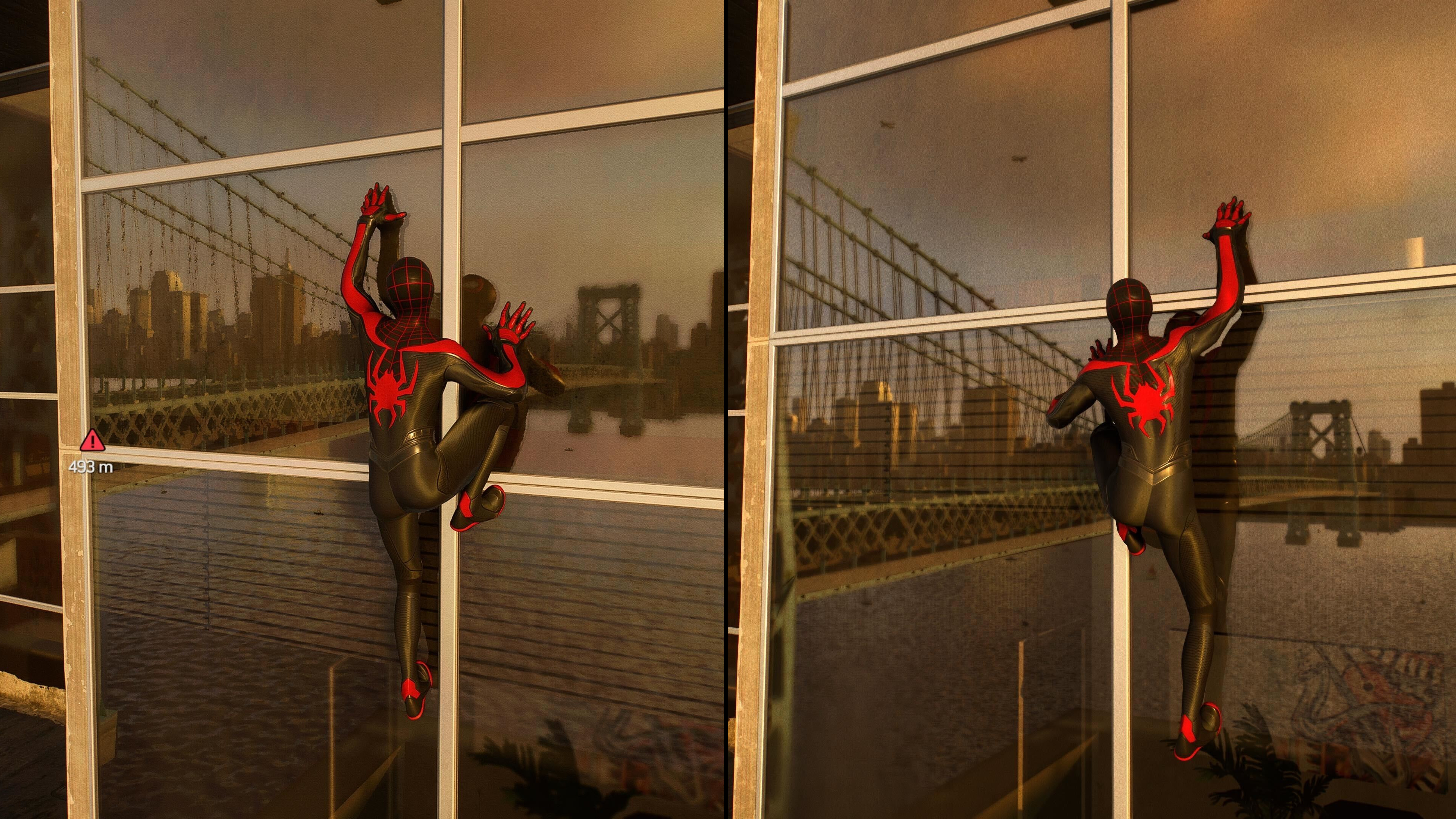
(Left) PS5, (Right) PS5 Pro
Your standard Performance Pro mode still packs a ray tracing boost, and the smooth 60fps framerates to match, but those who want to tinker with high-end settings are still sacrificing their speed. It’s still a sight to behold, as the streets below are near-perfectly replicated across the side of a building. Shadows cast across streets from the buildings that tower over feel far more natural, but they still do on the PS5 as well. This game feels made for such graphical features, with a new test for the system’s GPU around every street corner - and the PS5 Pro certainly delivers, no matter how subtle most of these effects are in the grand scheme of the wider game. How much you'll actually appreciate of that while you're zooming past buildings remains to be seen.
Insomniac has repeated this approach with Ratchet & Clank: Rift Apart, featuring both an all-in-one Performance Pro mode and a more detailed but slower Fidelity Pro option. I ran Corson V’s bustling cityscape on the PS5 (Performance RT) and the PS5 Pro (Performance Pro), and once again the snap of an increased framerate was tangible on the Pro. Spaceships floating around the central space seemed to move with more ease - but again, it’s not like things were janky on the previous console. They still glide well on 2020’s device, but there’s an extra special sense of slickness to the Pro’s handling of the same scene. With the Performance RT mode applied, though, the original PS5 version runs with lower detail in the background and a less polished color tone overall.
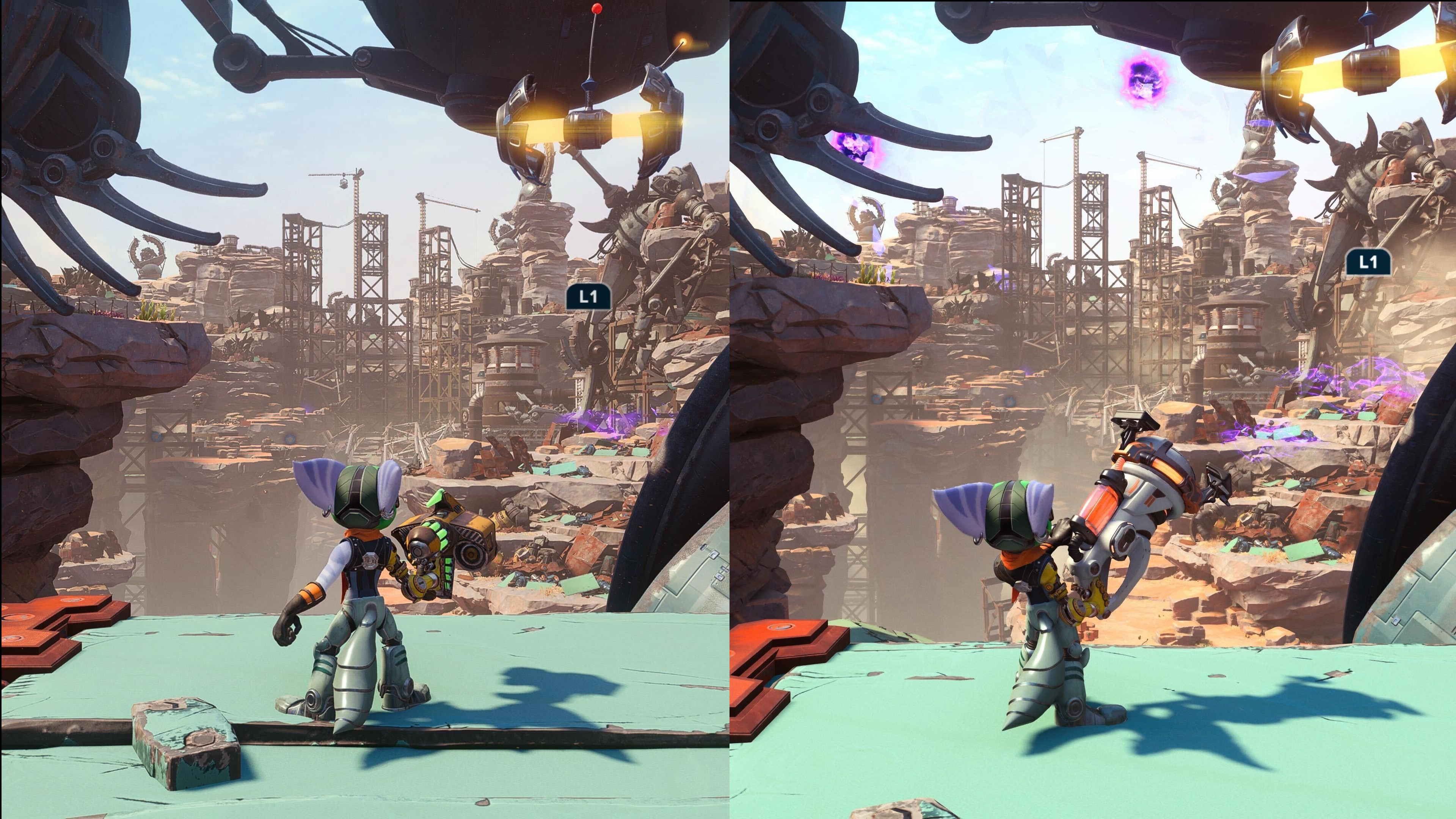
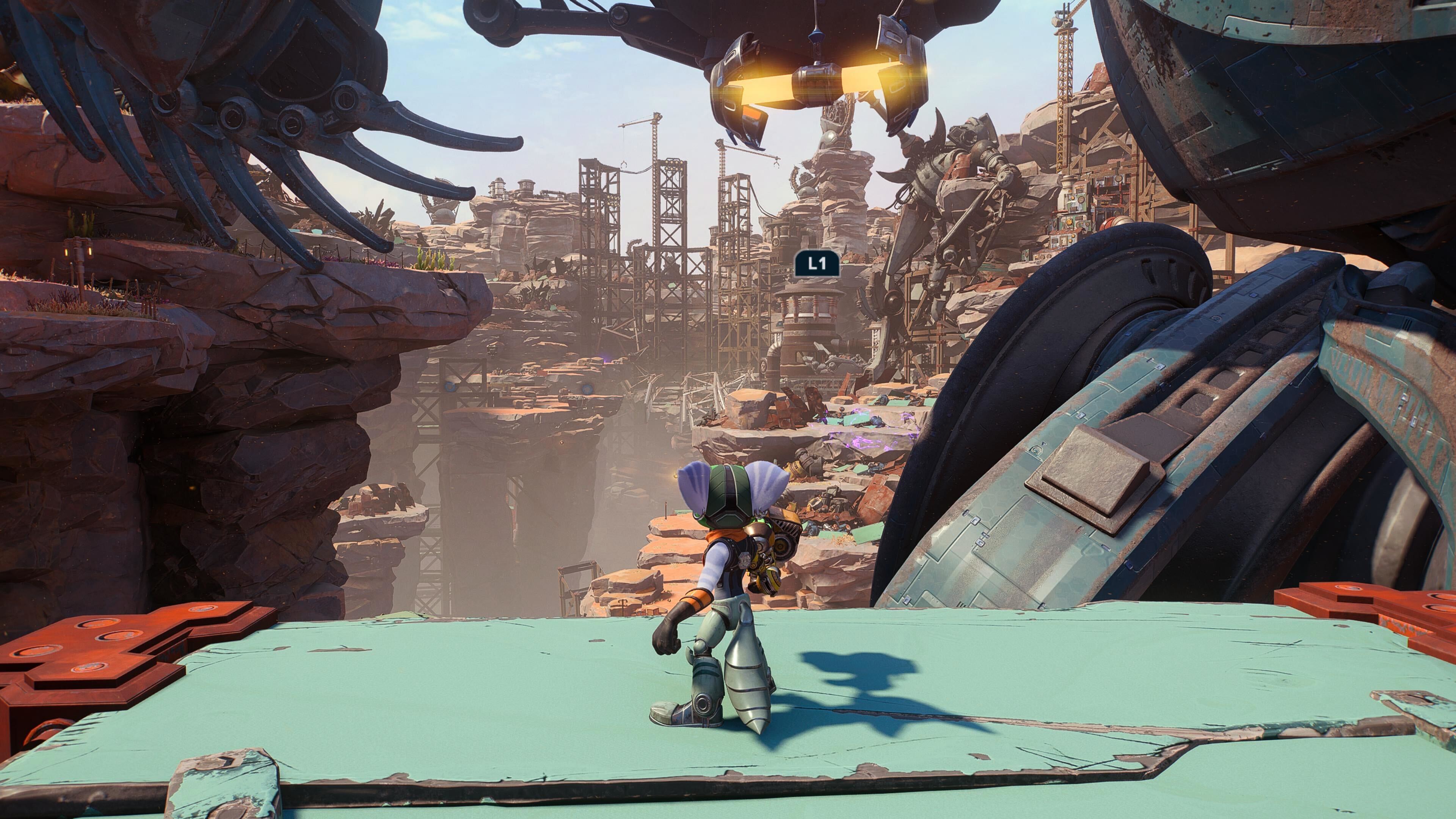
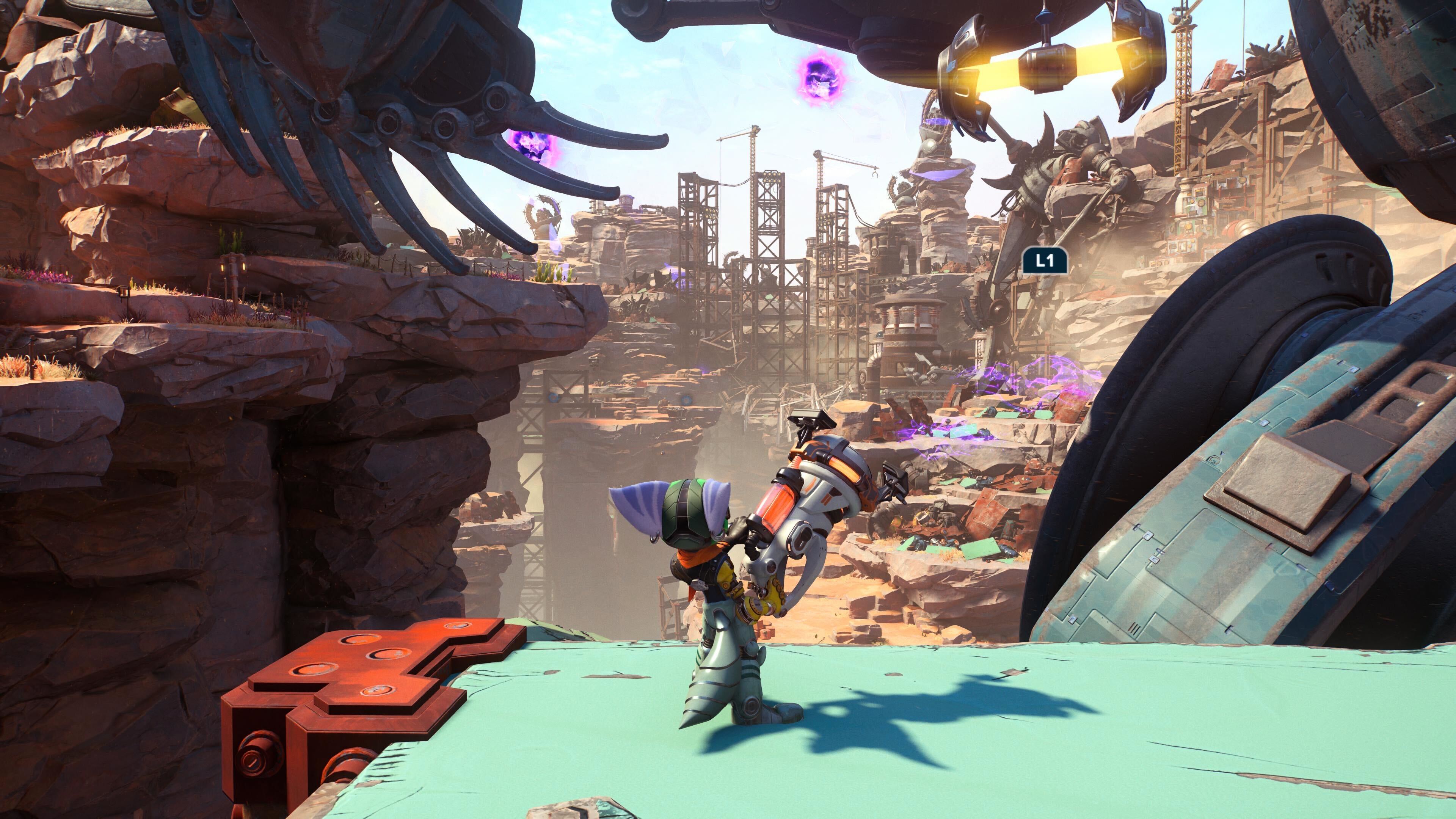
Standing at the edge of the quarry in Torren IV, I’m looking out over a wooden construction site, and on PS5’s Performance RT mode I’m not getting the full picture. Swapping over to the PS5 Pro, the same scene is filled with more wisps of dust, the beams carry a brighter detail with a less grainy tone. I can see more of the lower rungs of the structure as a whole, and there’s a greater sense of dimension to the backdrop.
These are the kinds of visual effects that are easy to pinpoint and demonstrate during play, but there’s a problem here. This is a console, and I’m perched on the edge of my coffee table turning my eyes square - that’s not how you play a console. Unless you’re one of the lucky few with a giant 80-inch display (or a particularly small living room) you’re not going to be pressed up against this screen in the same way you would a monitor setup. Taking a few steps back to the couch where I actually play, these details were far less apparent. Yes, if I squint I can see the extra details - but I’m more concerned with navigating tricky jumps and swatting monsters away when I’m actually playing. These extra features are going to be reserved for those playing in a desk setup on a monitor or on a massive 4K 120Hz TV.
The Last of Us Part 1’s PS5 Pro Enhanced patch brings a Pro Rendering mode to the game, the system’s bread and butter. Put simply, this is all about frames at 4K, with less emphasis on fancy ray-tracing effects. I found lighting to be of a similar quality across both PS5 (Performance and Fidelity) and PS5 Pro (Pro Rendering) across the Beyond the Wall mission. There is, however, a notable heaviness in frames on the original system, with a little more drag to every movement even felt in Performance mode. Framerates are much improved on PS5 Pro, with quick movements and camera pans keeping up naturally and that same slick feel that keeps Insomniac’s games feeling super smooth under the thumbs.
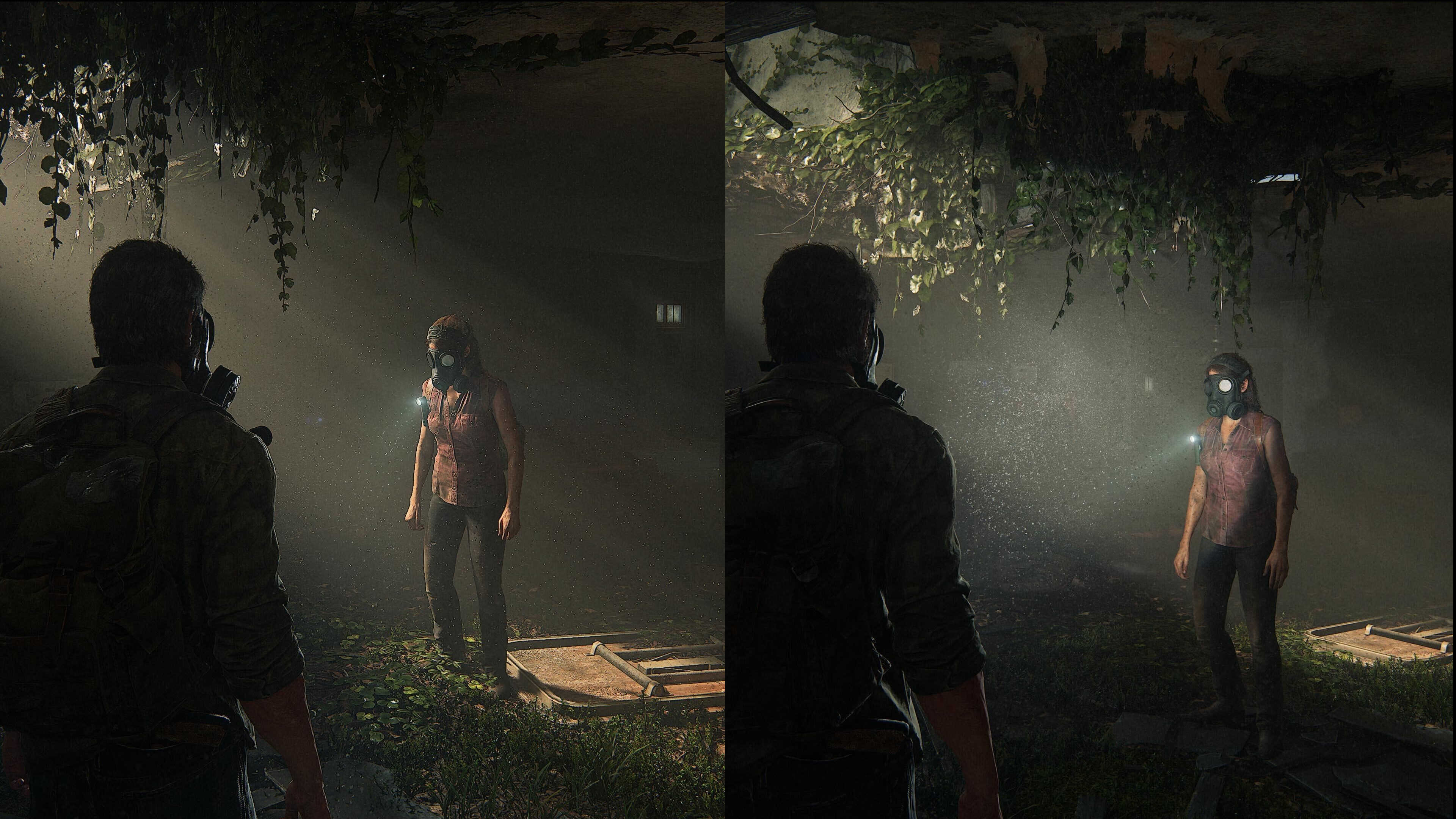
(Left) PS5, (Right) PS5 Pro
With the original console souped up to Fidelity mode, the PS5 Pro offered a similar graphical experience though with even more noticeable framerate boosts. Even in this setting, though the Pro managed to squeeze a little extra detail into smaller areas - I noticed more spores inside the building, especially when illuminated by the crack in the ceiling. There’s a greater number of smaller details applied in The Last Of Us Part 1 on PS5 Pro, producing a general sheen over the experience as a whole.
Hogwarts Legacy was the game I felt benefitted the least from the PS5 Pro’s enhancements. In this situation, framerates were slightly improved in the system’s HFR Performance mode, but the overall picture was softened considerably. Image quality seemed to take a major hit, the Pro’s boosted GPU didn’t seem to be working so hard here. Swapping that over to the Fidelity with Ray Tracing preset certainly fixed the issue, and still offered up similar framerates to the PS5’s more performance-based options. I’ll confess, I’ve only ever played Hogwarts Legacy on PC before which meant I was at the mercy of a 45-minute PS Plus game trial here. That gave me enough time to test framerates and graphical clarity across the first section of the game, but it was only in the destruction of the ice wall that I noticed any tangible picture improvements. While motion was smooth enough on both systems, and lighting and details seemed to remain fairly consistent between the two, the sharpness, reflections, and vibrancy of this block of ice as it shattered was noticeably improved on the PS5 Pro.
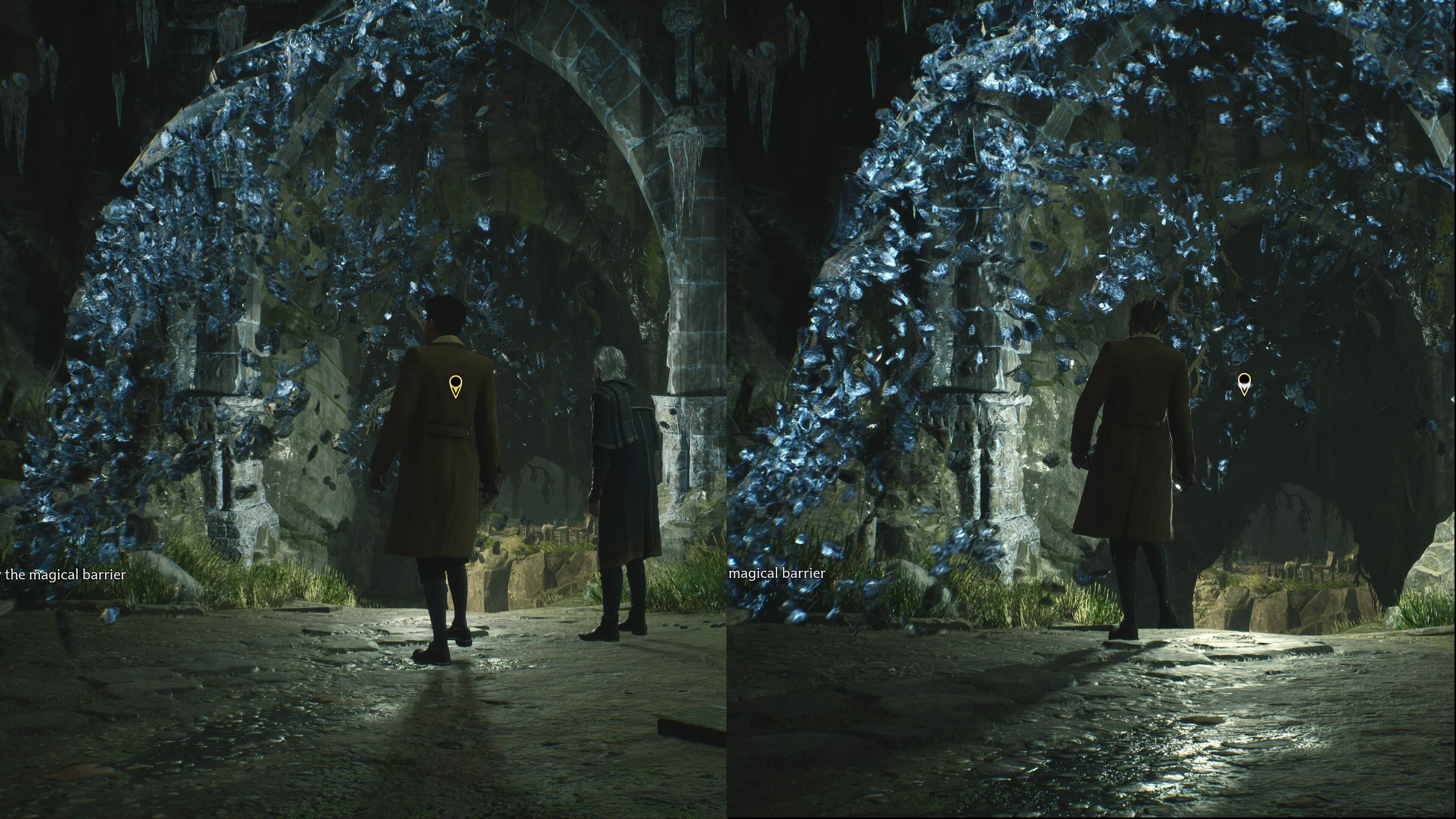
(Left) PS5, (Right) PS5 Pro
I would prefer to play my games on the PS5 Pro if I were given a free choice between the two, that’s pretty easy to say. There are noticeable differences between the systems, but the boost in framerates is going to have a much larger impact on day-to-day play than newer ray tracing, detailing, and textural improvements. It’s a subtle performance enhancement at the end of the day, though - Sony isn’t providing us with a full generational leap for that extra $200 / £200.
Games
Some games are going to utilize the PS5 Pro’s new performance power better than others, but the good news is that there’s already a strong supply of titles with patches either ready to go on day one or in the pipeline. These games are listed as ‘PS5 Pro Enhanced’ on the PS Store, and at the time of writing we’ve got over fifty heading our way for launch and a further 46 on the roadmap.
It’s safe to assume that Sony’s first-party darlings are going to be included on this roster - aside from those listed above, the Horizon series, Spider-Man: Miles Morales, Final Fantasy 7 Rebirth, Rise of the Ronin, The First Descendant, and Lords of the Fallen are all accounted for. Developers outside of this inner circle are also getting in on the action - Ubisoft has Assassin’s Creed Mirage and Star Wars Outlaws, EA has its latest sports outings, and Square Enix has Final Fantasy 7 Rebirth. If you’ve been keeping up with the best PS5 games over the last five years or so, chances are there’s going to be a patch for your collection coming soon.
Backwards Compatibility
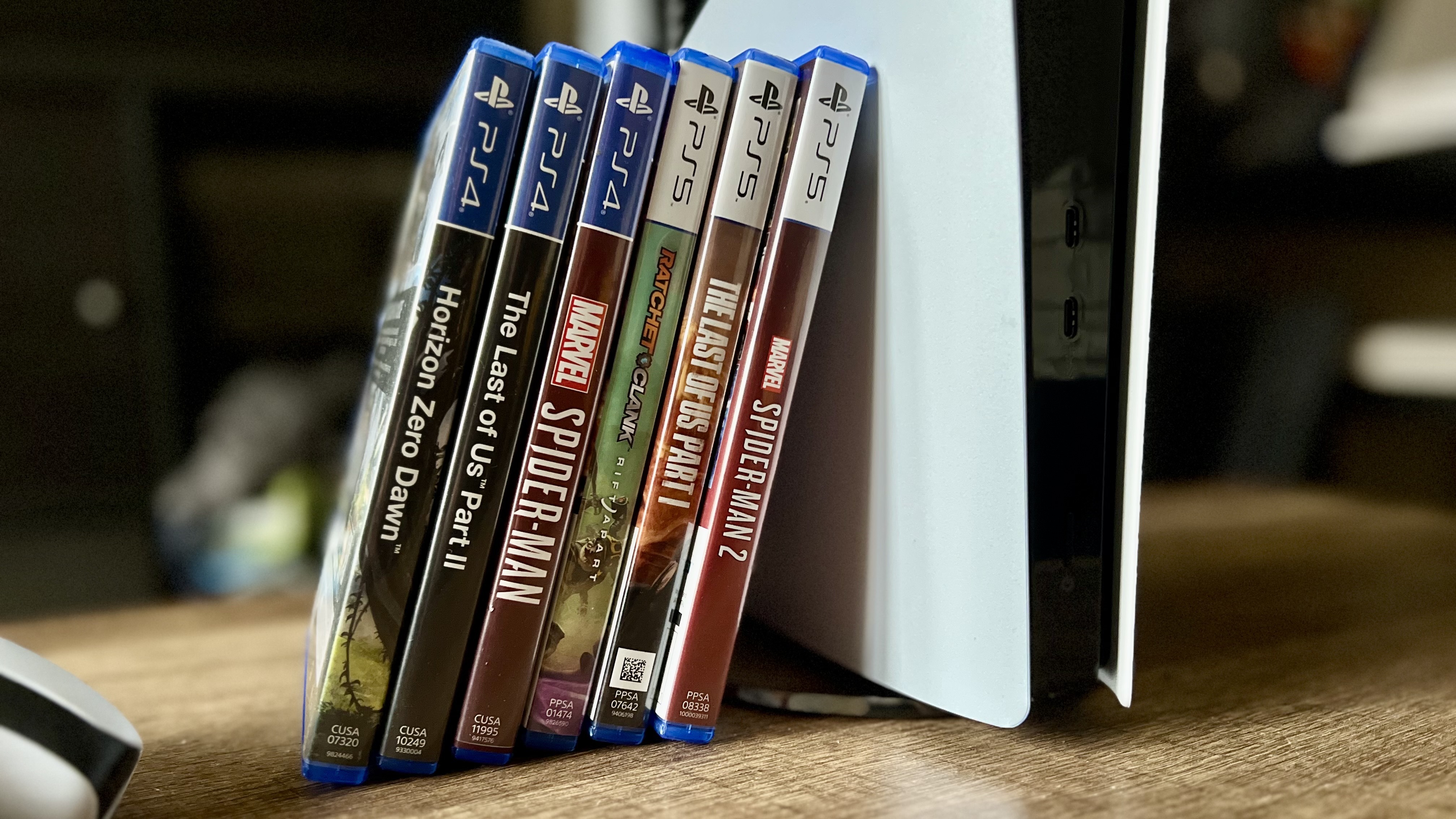
I didn’t think I would need to say too much about backwards compatibility in this review until I sat down to test Horizon Zero Dawn Remastered. This was one of the first games I ever mainlined back on the PS4 - Forbidden West was the reason I wanted a PS5 from day one (until it got delayed). This is the first time I’ve been stung by a digital-only console. Without shelling out $79.99 / £99.99 for the disc drive, my existing PS4 collection is redundant on PS5 Pro - and that means I’d have to pay the full $49.99 / £44.99 all over again rather than taking advantage of the $10 / £10 upgrade. The same is true for any disc game I own - technically, the PS5 Pro isn’t even backwards compatible with the PS5 from its own generation. That’s not a reason to leave it on the shelves, but it is disappointing that the full price of the console is effectively bumped up to $779.98 / £799.98 - and the numbers weren’t on the Pro’s side to begin with.
Of course, if you’ve always maintained a digital collection you’re all good to go. You can play PS4 and PS5 games straight from the console itself, with PS Plus Premium subscribers also jumping into PS One, PS2, PSP, and PS3 titles as well.
UI
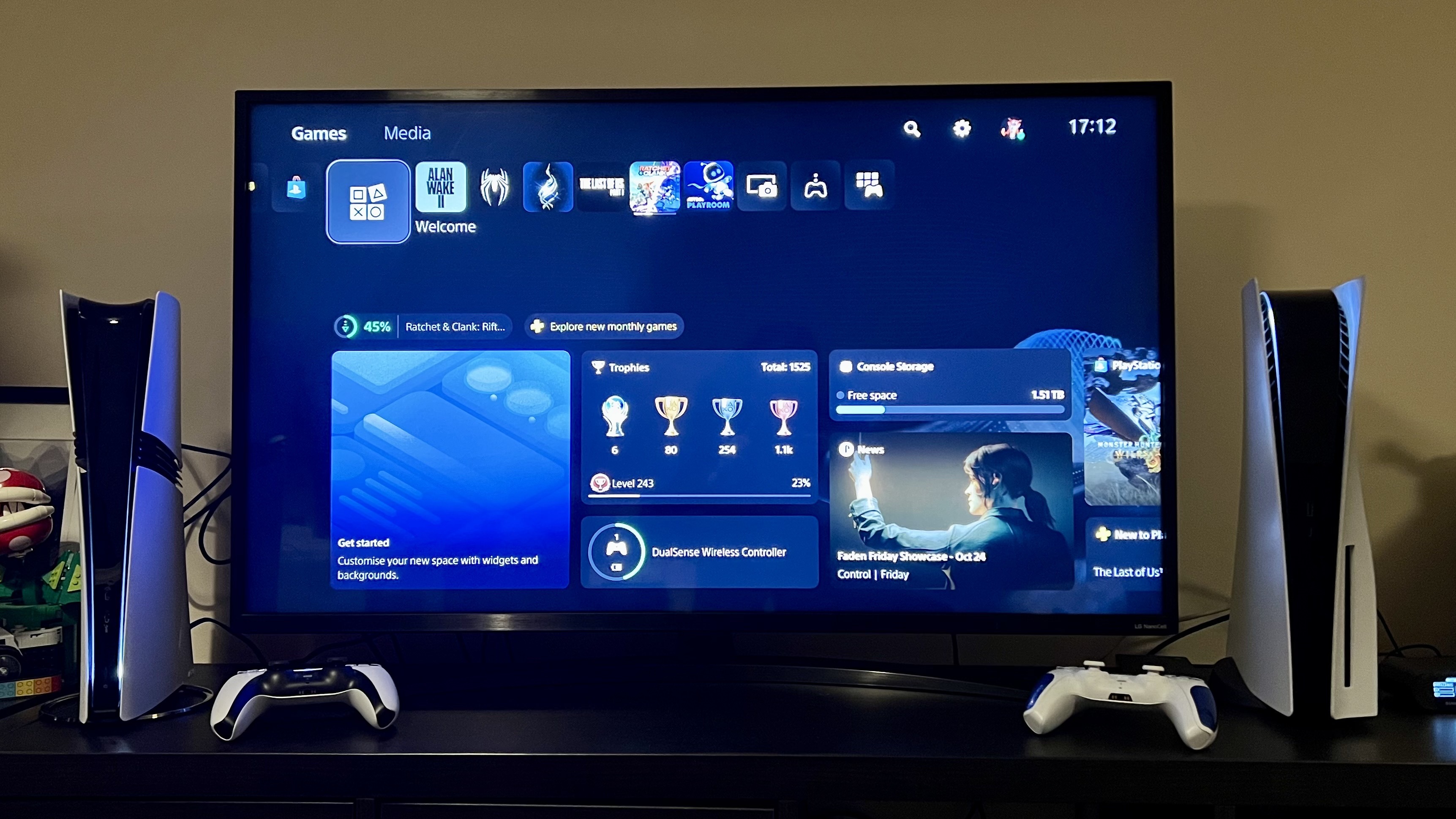
If you’ve already got a PS5 at home, the UI isn’t going to come as a surprise to you. This is the exact same home screen, navigation style, and control centre you’ve come to expect. If you’re using the PS5 Pro to break into Sony’s system for the first time, you’ll be met with a horizontally scrolling selection of your most recent apps and games (and a bigger library at the end) with PS Plus and PS Store options tagged onto the front as well.
Pressing the PS Button in-game brings up a smaller menu along the bottom of the screen, which acts as a quick switcher between games while giving you access to microphone, speaker, and other settings. This is also where you can view your current activities, trophy progress, and PS Plus game hints. There’s not much to explore here that hasn’t already been out in the wild for a while, though the new Welcome Page is a more recent update previous Xbox-ers might not know about. This is essentially a collection of customizable widgets that can quickly show the latest news about your games, your most recent screenshots, trophies, friend activity, download statuses, storage space, and controller battery. It’s a neat addition that removes some previously oddly placed features and brings it all together into a digestible homescreen.
Controller
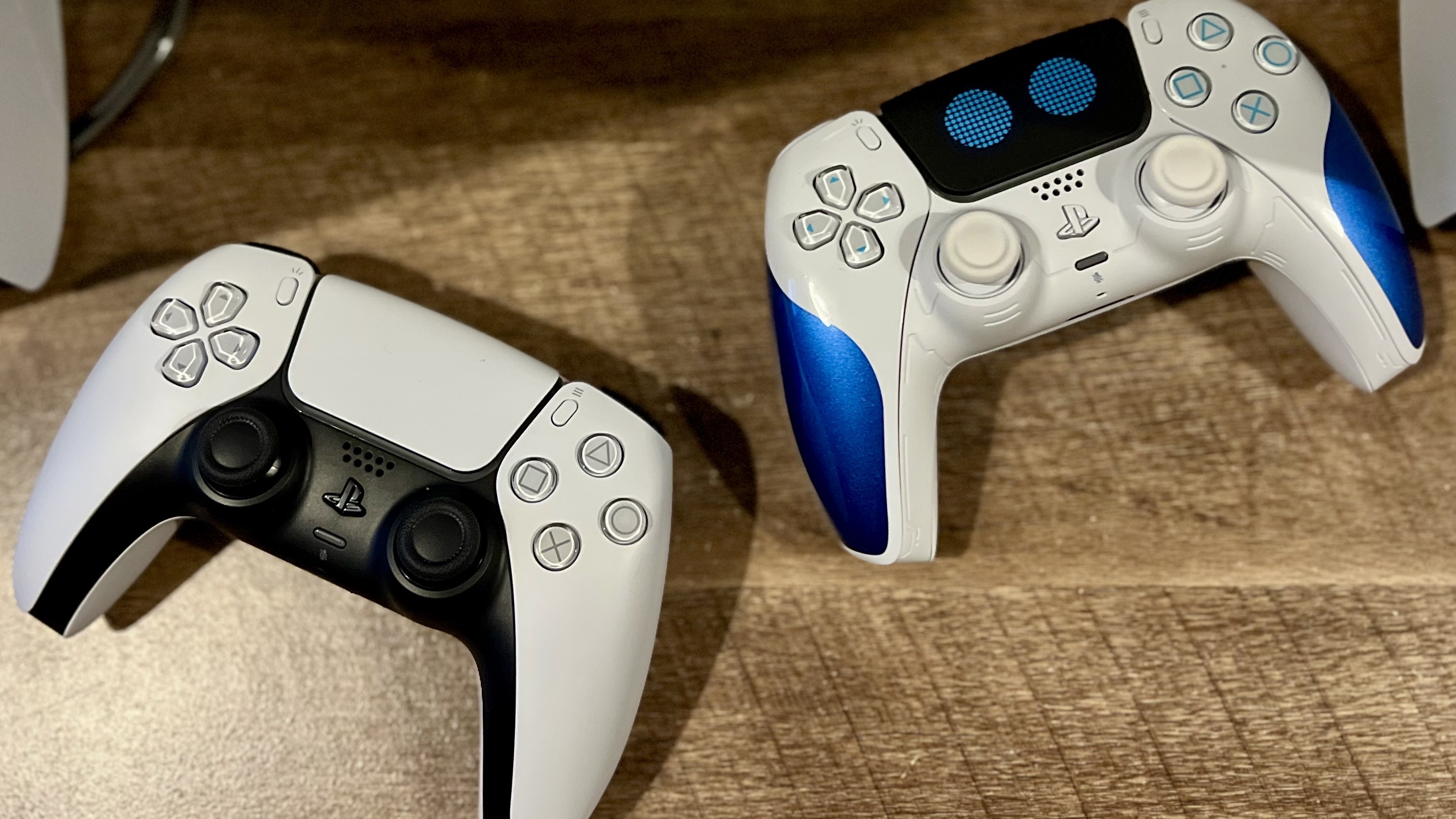
The PS5 Pro ships with a regular old DualSense (though the DualSense Edge is available for those after a more Pro experience). This is the same gamepad as you’d find in the box of any PS5 Slim - adaptive triggers and haptic feedback in tow. That’s not to downplay how great of a controller this is - our original DualSense review made it clear that this is one of the best controllers of the generation. Personally, it’s my favorite gamepad on the market, with the inbuilt mic and speakers, comfortable but reliable weighty feel, and unique trigger capabilities.
However, unboxing the PS5 Pro did confirm something I’ve been suspicious about for a while. I picked up an Astro Bot special edition controller in September, and noticed the face and d-pad buttons were far more satisfying than my original gamepad. They feel lighter but also more tactile under the thumb, with far more snap to them and a crisp feel. I originally thought my old controllers were simply showing their age, but the gamepad I received in the PS5 Pro box still felt mushy compared to special editions. The DualSense in the box of the $699.99 / £699.99 PS5 Pro isn’t even the best basic controller in Sony’s arsenal right now.
Should you buy the PS5 Pro?
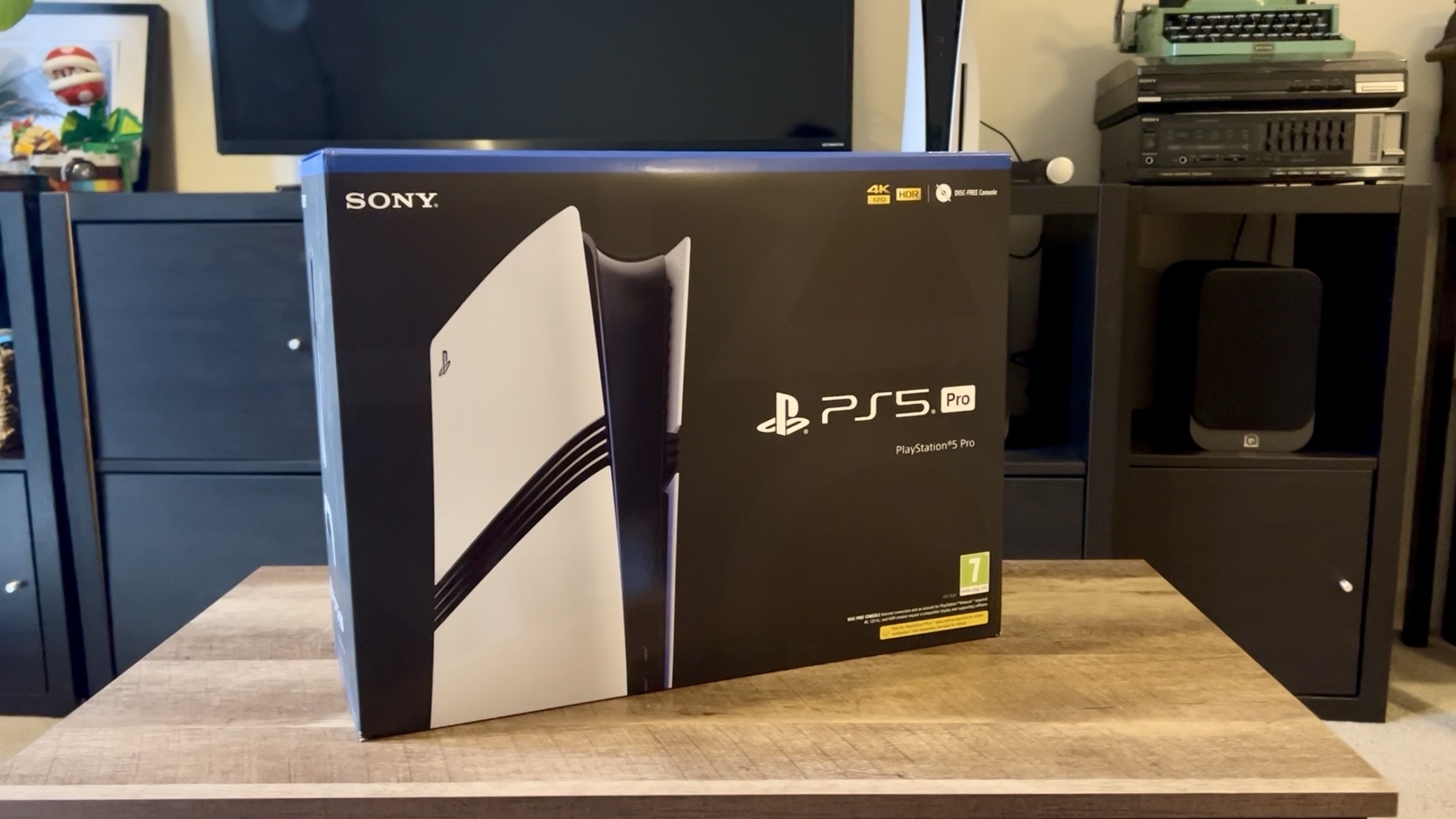
The question that’s been on everyone’s lips, especially since that price point was first announced, is going to be even more complicated to answer than I had originally thought. I was skeptical after the initial announcement - and some of those concerns have persisted throughout my testing process.
I wouldn’t buy the PS5 Pro myself, and when i’m not writing about hardware (and graphics in the realm of gaming laptops) I’m testing it, playing with it, or thinking about it. I’m lucky to earn enough to keep that hobby fairly stocked, and I’m happy to spend on upgrades that I know are going to enhance my enjoyment. I’m arguably Sony’s target audience for the PS5 Pro - a long-time PlayStation fan, with an aging day-one console, an appreciation for technological progress, and a budget for my gaming hobby. And yet I still wouldn’t buy a PS5 Pro.
It’s not that the console doesn’t deliver on pretty much everything it promised - it’s that that’s not enough when $700 is changing hands. Yes, games look better on this device, and - more noticeably from my testing - they run smoother. It’s the latter that’s going to provide more value to everyday players, though if I hadn’t trialed the two devices side by side I certainly wouldn’t have appreciated the Pro so much.
Graphical ray tracing, detail, and overall texture improvements are there - but they’re subtle. I’m impressed by them when I’m sitting an inch away from the screen, but I don’t expect them to make much of a difference in my overall enjoyment when I just want to sling some webs, spells, or Swingshots from the couch. Not when that $200 could buy me a PlayStation Portal or DualSense Edge instead - tangible changes to the way I play.
That’s not the full story, though. I would be happy to consider buying a PS5 Pro if there was just one change in my play habits - if I played from a gaming monitor. This is where Sony’s mid-cycle refresh thrives. After all, the brand has been quick to point out the system’s similarities to a gaming PC in most of its marketing up until this point. Consoles have been firmly in the living room territory for most of the industry’s life - but that’s been changing over the last few generations. More players are hooking their PS5s up to their desks, and Sony’s doubling down on this market.
The graphical boosts and framerate improvements aren’t for the living room dwellers - they’re for those up close and personal with their screens. The best PS5 monitors will show you all the ray tracing and detailing effects you’ve spent that money on in glorious clarity at speedy framerates. You simply won’t see that in a couch setup unless you’ve got an 80-inch display parked six feet from your eyes.
If you’ve got the cash to spend, and the setup to take advantage of it, the PS5 Pro remains a solid buy. It’s not going to give bargain hunters the value they need to feel justified in their purchase, but if you’re upgrading from an original console and want the new design it’s still well worth considering.
How I tested the PS5 Pro
I had one week to test the PS5 Pro, during which time I ran the following PS5 Pro Enhanced Games at the time of, or after, their official patch releases; Hogwarts Legacy, Marvel's Spider-Man 2, Ratchet & Clank: Rift Apart, and The Last of Us Part 1. I also tested across regular play in Fallout 76 and Doom Eternal, though neither games have enhanced patches at the moment. For more information on how we make our recommendations, check out the full GamesRadar+ Hardware Policy.
Check out our full guide to the best PS5 accessories on the market if you want to turbo-charge your setup, or take a look at the best PS5 headsets and best TVs for PS5 for more.




!["[T]he First and Fifth Amendments Require ICE to Provide Information About the Whereabouts of a Detained Person"](https://images.inkl.com/s3/publisher/cover/212/reason-cover.png?w=600)


